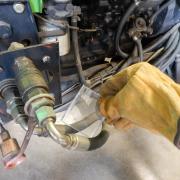Use the following format to cite this article:
Hydraulic safety. (2012) Farm and Ranch eXtension in Safety and Health (FReSH) Community of Practice. Retrieved from http://www.extension.org/pages/64565/hydraulic-safety.
Hydraulic systems on agricultural equipment are used to complete such maneuvers as lifting the buckets on skid steers or adjusting the position of combine headers. Hydraulic fluid moves through very small openings within an operating system, and it is under tremendous pressure that can exceed 2,000 pounds per square inch (psi). Some newer and larger pieces of equipment have hydraulic systems with pressures that exceed 3,000 psi. (Running water from a household faucet typically measures 40 psi.)
Hazards
Hydraulic systems and hydraulic fluid can be hazardous to workers in several common scenarios.
Improper Couplings
Never mix low- and high-pressure coupler components (that is, do not connect a low-pressure component to a high-pressure system). Mismatched componenets may cause a rupture in a hose or fitting.
Pinhole Leaks
Never use your hand to locate a leak in a hydraulic line. Because hydraulic fluid—often oil—is highly pressurized, compressed fluid released through a leak can penetrate the skin or eyes, causing severe injury, such as gangrene. Injection injuries from high-pressure hydraulic fluid require immediate medical care.
When trying to locate a leak in a hydraulic line, wear eye protection and gloves. Run a piece of paper, wood, cardboard, or Plexiglas along the hydraulic line (as shown below) to determine the location of the leak. Always relieve the hydraulic pressure in an operating system before detaching or attaching a hydraulic line to make necessary repairs.

(Source: Pennsylvania State University. Agricultural Safety and Health)
Component Removal or Adjustment
Release the hydraulic pressure in an operating system prior to removing or adjusting components. The hot fluid in the system is under extreme pressure. If a worker is exposed to hydraulic fluid while removing or adjusting components, he or she may sustain burns, bruises, cuts, abrasions, or injection of fluid into the skin.
Maintenance
Proper maintenance is critical for all types of machinery and equipment, but it is imperative that you follow proper safety measures when performing maintenance.
- Wear personal protective equipment (PPE) when performing maintenance on hydraulic systems, including gloves and eye protection.
- Do not rely solely on the hydraulic lift if you must work on hydraulic components with the system raised. Set the working unit on blocks as a precautionary measure.
- Unless you are bleeding the hydraulic system, do not run the machine engine when you are servicing the system.
- Hydraulic fluid can be extremely hot and can cause severe burns, so let the hydraulic system cool before changing lines, connections, filters, or fittings.

(Source: Pennsylvania State University. Agricultural Safety and Health)
- Regularly examine the hydraulic lines for leaks and wear (as shown above).
- Coat the cylinder rods with a lubricant that provides rust protection.
- Periodically replace filters, and keep hydraulic oil away from contaminants; dirt is the biggest culprit in hydraulic system damage.
- Before removing the cylinders from working units, make sure that the units are resting on the ground, safety stands, or safety blocks and that the engine is shut off.
- Use a chain hoist, floor jack, or other type of assistive device if you need to remove heavy hydraulic pumps or control valves.
Safe Operating Procedures
Follow these recommendations when using equipment with hydraulic systems:
- Before leaving the machine, lower the hydraulic work unit to the ground and relieve hydraulic pressure by moving the control valve back and forth several times.
- Park the machine in an area where children are unlikely to come into contact with it.
- To keep the machine in place during transportation, lock the cylinder stops.
- Use cylinder stops, locks, or blocks for raised equipment or components when servicing hydraulic components or performing maintenance.
- To reduce the risk of escaping oil, make sure all the line connections within the system are tight.
- Use a nonvolatile cleaning solution when washing parts.
- Keep hydraulics properly adjusted for better control of the machine.
Use the following format to cite this article:
Hydraulic safety. (2012) Farm and Ranch eXtension in Safety and Health (FReSH) Community of Practice. Retrieved from http://www.extension.org/pages/64565/hydraulic-safety.
Sources
American Society of Agricultural and Biological Engineers (ASABE). (2008) ASAE S489 Hydraulic pressure available on agricultural tractors for remote use with implements. St. Joseph, MI. Retrieved from https://elibrary.asabe.org/.
Ayers, P. (n.d.) Hydraulic systems safety. Colorado State University Extension. Retrieved from http://nasdonline.org/static_content/documents/1100/d000891.pdf.
Harshman, W., Yoder, A., Hilton, J., and Murphy, D. (2012) Implements with hydraulic components: HOSTA Task Sheet 5.5. Pennsylvania State University Department of Agricultural and Biological Engineering. Retrieved from http://www.extension.org/sites/default/files/NSTMOP%20Task%20Sheets%20Se….
Safe use of hydraulic systems. (2006) The Ohio State University Extension, Tailgate Safety Training for Landscaping and Horticultural Services. Retrieved from http://nasdonline.org/139/d001703/safe-use-of-hydraulic-systems.html.
Safety management for landscapers, grounds-care businesses and golf courses (1st ed.). (2001) Moline, IL: John Deere Publishing.
